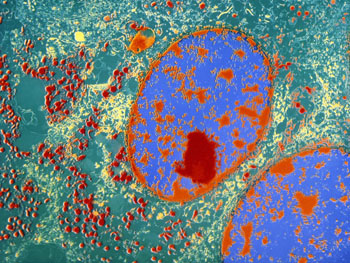New Imaging Agent Detects Rare Neuroendocrine Tumors
By MedImaging International staff writers
Posted on 23 Jun 2016
A novel radioactive probe will help locate tumors in adult and pediatric patients suffering from somatostatin receptor positive neuroendocrine tumors (NETs).Posted on 23 Jun 2016
Netspot, a product of Advanced Accelerator Applications (AAA; Saint-Genis-Pouilly, France), is a sterile, single-dose kit for the preparation of Ga 68 dotatate injection, a radioactive diagnostic agent used in positron emission tomography (PET) imaging. The imaging agent functions as an analogue of somatostatin, with uptake of the dotatate reflecting levels of somatostatin receptor density in NETs. As Netspot contributes to the overall long-term cumulative radiation exposure, patients should drink and urinate as often as possible during the first hours following administration to help reduce risk.

Image: Neuroendocrine tumor cells (Photo courtesy of MedScape).
“Use of advanced imaging techniques to detect rare neuroendocrine tumors at an early stage in patients is critical,” said Libero Marzella, MD, PhD, director of the division of medical imaging products at the U.S. Food and Drug Administration (FDA, Silver Spring, MD, USA) Center for Drug Evaluation and Research (CDER). “Netspot provides another diagnostic tool whose results will help clinicians determine the location and extent of the tumor. This information is important for planning the appropriate course of therapy.”
“The FDA approval of Netspot is a key milestone in our mission of improving the lives of NET patients,” said Stefano Buono, CEO of AAA. “NETSPOT has the potential to significantly improve the accuracy of NET diagnosis, while reducing radiation exposure for patients. We believe that the use of Netspot should also offer increased comfort for patients by potentially shortening a procedure that is currently performed over 24 hours or more to just a few hours.”
NETs are rare benign or malignant tumors that develop in the hormone-producing cells of the body’s neuroendocrine system. These cells are found throughout the body in distinct organs, such as the stomach, intestines, pancreas, lungs, and other locations. NETs have receptors for somatostatin, a hormone that regulates the endocrine system. The estimated incidence of NETs for the combined populations of the United States and the European Union is approximately 47,300 patients per year.
Related Links:
Advanced Accelerator Applications
U.S. Food and Drug Administration














